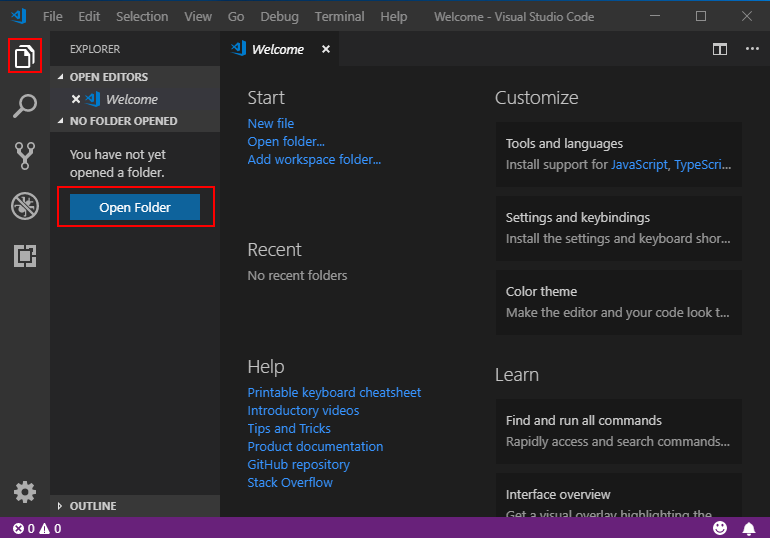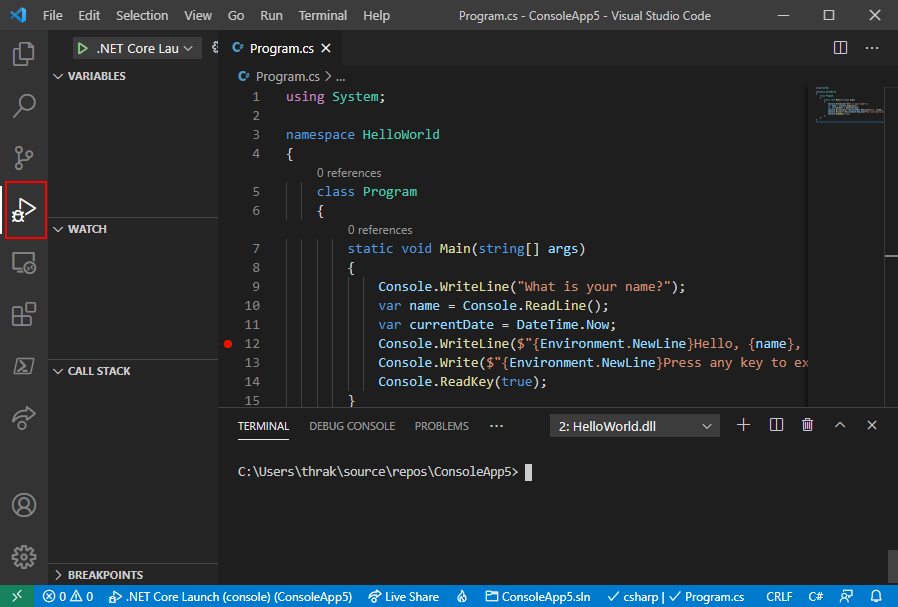- C# Visual Studio Code Examples
- Download Visual Studio Code For Windows 10
- C# Visual Studio Code Compile
- C# Script Starting Visual Studio Code
Visual Studio Code; C# for Visual Studio Code (latest version).NET Core 3.1 SDK or later; The Visual Studio Code instructions use the.NET Core CLI for ASP.NET Core development functions such as project creation. You can follow these instructions on any platform (macOS, Linux, or Windows) and with any code. Why you might prefer it: The Cable Matters Slim Series Long USB-C to USB-C Charging Cable is a luxurious 10 feet in length (though it also comes in 3-foot and 6-foot versions), allowing you to. How to Setup C# in Visual Studio Code Full SetupDownload the full source code of application here:https://codingshiksha.com/blogs/android/firebase-phone-auth.
C# Visual Studio Code Examples

C or Do is the first note of the C majorscale, the third note of the A minor scale (the relative minor of C major), and the fourth note (F, A, B, C) of the Guidonian hand, commonly pitched around 261.63 Hz. The actual frequency has depended on historical pitch standards, and for transposing instruments a distinction is made between written and sounding or concert pitch.
In English the term Do is used interchangeably with C only by adherents of fixed-Do solfège; in the movable Do system Do refers to the tonic of the prevailing key.
Frequency[edit]

Historically, concert pitch has varied. For an instrument in equal temperament tuned to the A440 pitch standard widely adopted in 1939, middle C has a frequency around 261.63 Hz (for other notes see piano key frequencies). Scientific pitch was originally proposed in 1713 by French physicist Joseph Sauveur and based on the numerically convenient frequency of 256 Hz for middle C, all C's being powers of two. After the A440 pitch standard was adopted by musicians, the Acoustical Society of America published new frequency tables for scientific use. A movement to restore the older A435 standard has used the banners 'Verdi tuning', 'philosophical pitch' or the easily confused scientific pitch.
Octave nomenclature[edit]
Middle C[edit]
Middle C (the fourth C key from left on a standard 88-key piano keyboard) is designated C4 in scientific pitch notation, and c′ in Helmholtz pitch notation; it is note number 60 in MIDI notation.[1]
While the expression Middle C is generally clear across instruments and clefs, some musicians naturally use the term to refer to the C note in the middle of their specific instrument's range. C4 may be called Low C by someone playing a Western concert flute, which has a higher and narrower playing range than the piano, while C5 Rachel maddow twitter. (523.251 Hz) would be Middle C. This technically inaccurate practice has led some pedagogues to encourage standardizing on C4 as the definitive Middle C in instructional materials across all instruments.[2]
On the Grand Staff, middle-C is notated with a ledger line above the top line of the bass staff or below the bottom line of the treble staff. Alternatively, it is written on the centre line of a staff using the alto clef, or on the fourth line from the bottom, or the second line from the top, of staves using the tenor clef.
Other octaves[edit]
In vocal music, the term High C (sometimes less ambiguously called Top C[3]) can refer to either the soprano's C6 (1046.502 Hz; c′′′ in Helmholtz notation) or the tenor's C5; both are written as the C two ledger lines above the treble clef but the tenor voice sings an octave lower. The term Low C is sometimes used in vocal music to refer to C2 because this is considered the divide between true basses and bass-baritones: a basso can sing this note easily, whereas other male voices, including bass-baritones, typically cannot.
Tenor C is an organ builder's term for small C or C3 (130.813 Hz), the note one octave below Middle C. Marina abramovic memoir. In stoplists it usually means that a rank is not full compass, omitting the bottom octave.

Designation by octave[edit]
| Scientific designation | Helmholtz designation | Octave name | Frequency (Hz) | Other names | Audio |
|---|---|---|---|---|---|
| C−1 | C͵͵͵ or ͵͵͵C or CCCC | Octocontra | 8.176 | Play | |
| C0 | C͵͵ or ͵͵C or CCC | Subcontra | 16.352 | Play | |
| C1 | C͵ or ͵C or CC | Contra | 32.703 | Play | |
| C2 | C | Great | 65.406 | Low C, cello C, 8' C (see organ pipe length) | Play |
| C3 | c | Small | 130.813 | 4' C or tenor C (organ), viola C | Play |
| C4 | c′ | One-lined | 261.626 | Middle C | Play |
| C5 | c′′ | Two-lined | 523.251 | Treble C, high C (written an octave higher for tenor voices)[4] | Play |
| C6 | c′′′ | Three-lined | 1046.502 | High C (soprano) | Play |
| C7 | c′′′′ | Four-lined | 2093.005 | Double high C[citation needed] | Play |
| C8 | c′′′′′ | Five-lined | 4186.009 | Eighth octave C, triple high C | Play |
| C9 | c′′′′′′ | Six-lined | 8372.018 | Quadruple high C | Play |
| C10 | c′′′′′′′ | Seven-lined | 16744.036 | Quintuple high C | Play |
Note that for a classical piano and musical theory, the middle C is usually labelled as C4; However, in the MIDI standard definition (like the one used in Apple's GarageBand), this middle C (261.626 Hz) is labelled C3. In practice, a MIDI software can label middle C (261.626 Hz) as C3-C5, which can cause confusion, especially for beginners. Download alienware aurora-r3 driver.
Graphic presentation[edit]

Download Visual Studio Code For Windows 10
Scales[edit]
Common scales beginning on C[edit]
- C Major: C D E F G A B C
- C Natural Minor: C D E♭ F G A♭ B♭ C
- C Harmonic Minor: C D E♭ F G A♭ B C
- C Melodic Minor Ascending: C D E♭ F G A B C
- C Melodic Minor Descending: C B♭ A♭ G F E♭ D C

Diatonic scales[edit]
C# Visual Studio Code Compile
- C Ionian: C D E F G A B C
- C Dorian: C D E♭ F G A B♭ C
- C Phrygian: C D♭ E♭ F G A♭ B♭ C
- C Lydian: C D E F♯ G A B C
- C Mixolydian: C D E F G A B♭ C
- C Aeolian: C D E♭ F G A♭ B♭ C
- C Locrian: C D♭ E♭ F G♭ A♭ B♭ C
C# Script Starting Visual Studio Code
Jazz melodic minor[edit]
- C Ascending Melodic Minor: C D E♭ F G A B C
- C Dorian ♭2: C D♭ E♭ F G A B♭ C
- C Lydian Augmented: C D E F♯ G♯ A B C
- C Lydian Dominant: C D E F♯ G A B♭ C
- C Mixolydian ♭6: C D E F G A♭ B♭ C
- C Locrian ♮2: C D E♭ F G♭ A♭ B♭ C
- C Altered: C D♭ E♭ F♭ G♭ A♭ B♭ C
See also[edit]
References[edit]
- ^'MIDI Note/Key Number Chart', computermusicresource.com
- ^Large, John (February 1981). 'Theory in Practice: Building a Firm Foundation'. Music Educators Journal. 32: 30–35.
- ^Harold C. Schonberg (November 4, 1979). 'Birgit Nilsson – The Return of a Super-Soprano'. The New York Times.
- ^'The Note That Makes Us Weep' by Daniel J. Wakin, The New York Times, September 9, 2007
